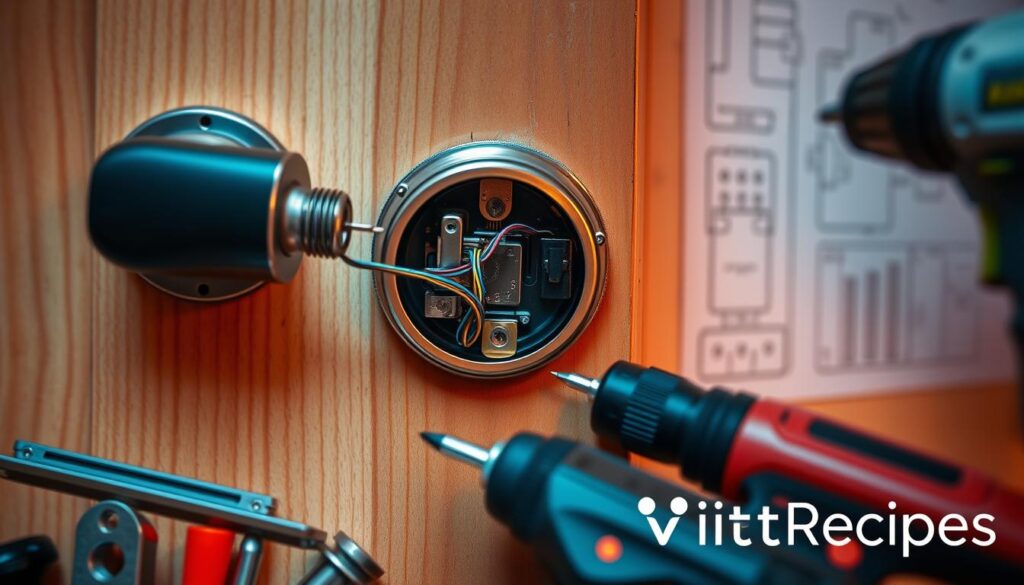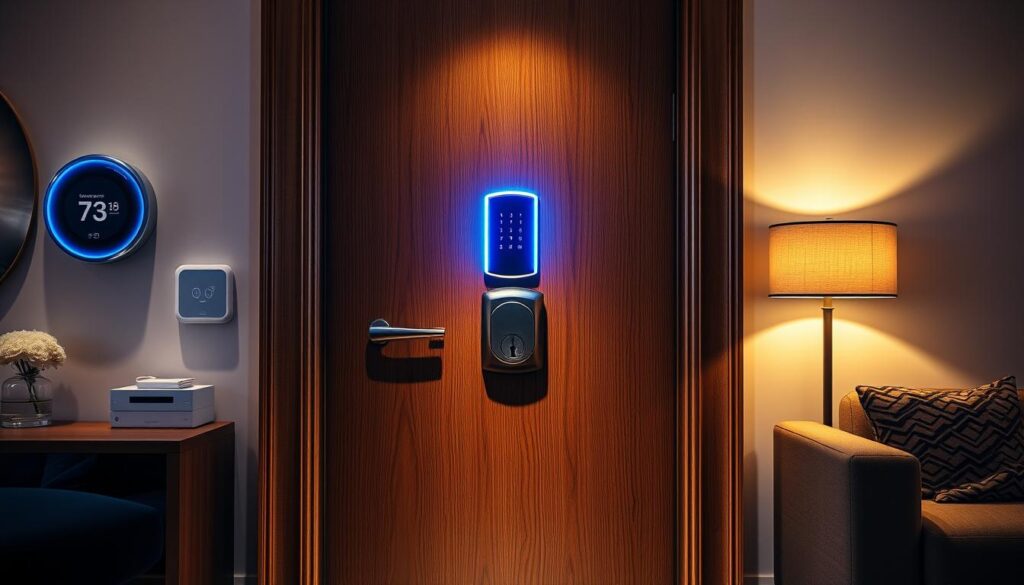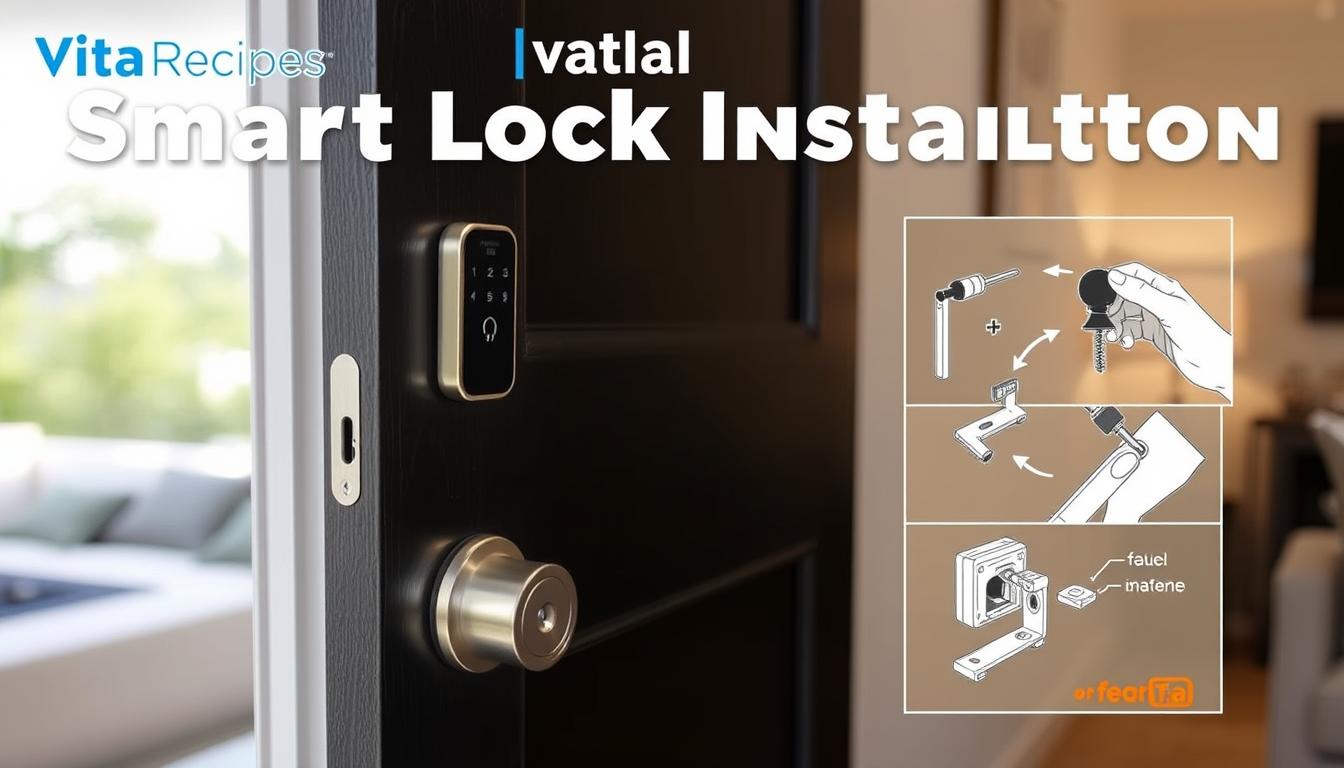Technology is changing how we secure our homes. Smart locks are now a top choice for keeping your doors safe. They use keypads, apps, or even fingerprints to unlock doors. This makes them great for homes with teens, lots of guests, or service people.
Installing a smart lock means taking out your old lock and putting in the new one. Then, you set up the digital parts. This guide will help you through it all, making sure your new smart lock works perfectly.
Key Takeaways
- Smart locks provide remote accessibility and enhanced security features compared to traditional locks.
- Compatibility with smart home systems is crucial for seamless integration and user experience.
- Biometric smart locks, such as those with fingerprint recognition, offer high security and convenience.
- Following the manufacturer’s instructions is essential for proper installation and functionality.
- Checking industry security standards is recommended before purchasing and installing a smart lock.
Understanding Smart Locks and Their Benefits
Smart locks are electronic systems that let you access your home securely. They are different from old-fashioned locks because they offer more features. These features make your life easier, give you more control, and keep your home safe.
What is a Smart Lock?
A smart lock is an electronic door lock that you can control from your phone or with voice commands. You don’t need keys anymore. Instead, you can unlock your door with a code, your fingerprint, or your phone.
Benefits of Smart Locks Over Traditional Locks
- Keyless entry for added convenience
- Remote access and control to lock/unlock your door from anywhere
- Activity logs to track who enters and exits your home
- Integration with smart home automation systems for seamless security
How Smart Locks Enhance Home Security
Smart locks make your home safer by fixing problems with old locks. They stop the worry of lost or stolen keys. They also let you see who’s coming and going, and they have strong security features like encryption.
With a smart lock lasting about 5 years, you can feel safe and secure at home.
| Smart Lock Feature | Benefit |
|---|---|
| Biometric access (e.g., fingerprint, facial recognition) | Highly secure access control, suitable for family homes |
| Electric cylindrical and mortise smart locks | Ideal for commercial buildings, offering high security and customization |
| Electric push bar smart locks | Suitable for emergency exits in commercial settings, ensuring safety compliance |
| Wi-Fi smart locks | Provide convenience with remote access and integration, but vulnerable to hacking |
| Z-Wave smart locks | Utilize secure, encrypted communication and low power consumption, require compatibility with Z-Wave hubs |
| Geofencing smart locks | Automate locking and unlocking based on location, but may experience false triggers or delayed responses |
Smart locks bring many benefits to your home’s security and convenience. Knowing about the different types of smart locks helps you pick the best one for you.
Choosing the Right Smart Lock for Your Home
Smart locks are becoming more popular for homeowners. They offer better security and convenience. With many types and brands out there, picking the right one can be tough. We’ll look at different smart lock types, what to consider, and top brands to help you choose.
Types of Smart Locks Available
There are many smart lock types, each with special features. Here are a few common ones:
- Fingerprint-enabled locks: These use your finger to unlock the door.
- Keypad locks: You enter a code to unlock these locks.
- Bluetooth-enabled locks: These connect to your phone for remote access.
- Wi-Fi-enabled locks: You can control these locks from anywhere with an internet connection.
Key Considerations for Selecting a Smart Lock
When picking a smart lock, think about these important factors:
- Connection Type: Choose between Bluetooth or Wi-Fi for different features.
- Power Source: Decide between battery or hardwired power based on your needs.
- Brand Reputation: Look at the brand’s history, reviews, and warranty.
- Smart Home Compatibility: Make sure the lock works with your home automation system.
Popular Smart Lock Brands to Consider
Here are some top smart lock brands:
- August Smart Locks: Known for design and features, August locks are easy to install.
- Schlage Smart Locks: Schlage offers strong security and works with many home systems.
- Yale Smart Locks: Yale locks are great for homes and businesses, focusing on ease and integration.
- Kwikset Smart Locks: Kwikset has many smart lock options, including keypad and Bluetooth models.
By looking at smart lock types, key factors, and top brands, you can find the best smart lock for your home. Think about your security and convenience needs to make the best choice.
Tools Needed for Smart Lock Installation
Installing a smart lock needs the right tools for a smooth process. The tools needed can change based on the smart lock model and your door type. But, there are common tools needed for most installations.
Common Tools Required
- Screwdrivers (both flathead and Phillips head)
- Drill
- Chisel (for mortise locks)
- Tape measure
- Level
Additional Tools for Specific Lock Types
Some smart locks need extra tools for installation. For example, mortise locks might need a hole saw or special drill bits. Rim locks are usually easier to install because they’re surface-mounted and don’t need deep drilling or chiseling.
Safety Gear You Should Use
Safety is key during installation. Wear gloves and safety glasses to avoid injuries. Also, keep the instruction manual handy for any safety tips or specific steps from the manufacturer.
| Lock Type | Expertise Level | Additional Tools Required |
|---|---|---|
| Mortise Locks | High | Hole saw, specialized drill bits |
| Single Latch/Deadbolt Locks | Moderate to High | N/A |
| Rim Locks | Low | N/A |
Having the right smart lock installation tools and door lock installation kit makes installation easier. Always prioritize safety when improving your home’s security.
Preparing Your Door for Installation
Before starting the smart lock installation, make sure your door is ready. You need to check if your door fits the new lock, remove the old one, and clean the surface. This step is key for a smooth transition.
Assessing Your Door’s Compatibility
First, check if your door fits the smart lock you picked. Measure your door’s thickness to match the lock’s needs. Also, think about your door’s material. Some smart locks work better with wood or metal.
Removing Your Existing Lock
To fit the new smart lock, you must remove the old one. Start by unscrewing any screws you see. Then, find and remove any hidden pins that hold the lock. If your doorknob has no screws, look for small holes to find the release pin. Remove the old lock carefully, noting any door damage for the new setup.
Clean-Up and Door Preparation
After taking out the old lock, clean your door well. This ensures the new smart lock fits perfectly. You might need to sand or fill holes to make the surface even. A clean, prepared door is vital for a secure and nice-looking smart lock.
By checking your door’s fit, removing the old lock, and cleaning it, you’re ready for a great smart lock installation. This will boost your home’s security and convenience.
Step-by-Step Installation Process
Setting up a smart lock in your home is easy and can make your home safer and more convenient. Whether you choose a Wi-Fi or Bluetooth smart lock, the steps are similar. This ensures a smooth switch from your old lock to a new smart system.
Installing the Smart Lock Hardware
Start by taking out your old deadbolt and getting your door ready for the new smart lock. Make sure your door fits the smart lock you picked. Most locks work with standard doors, but always check the manufacturer’s guide.
Next, put in the new deadbolt and make sure it’s right. Then, attach the outside and inside panels and connect any wires. If your lock needs batteries, put them in or connect it to power as the guide says.
Setting Up the Smart Lock App
After setting up the hardware, download the smart lock app and make an account. Follow the app’s instructions to link your lock to Wi-Fi or Bluetooth, depending on your lock.
In the app, you can set up codes, fingerprints, or other ways to get in. This lets you and your family unlock the door without a key.
Testing Your Smart Lock Functionality
Now, test your smart lock. Make sure it works well, both by hand and through the app. Check for remote access, alerts, and smart home connections to see if everything works right.
Adjust the lock if needed to make sure it’s secure and works well. By following these steps, you can set up your smart lock and enjoy better security and convenience.
| Feature | Keypad-only Locks | Bluetooth-enabled Locks | Wi-Fi-connected Locks |
|---|---|---|---|
| Backup Key Option | Yes | Yes | Yes |
| Battery-powered | Yes | Yes | Yes |
| Multiple User Codes | Yes | Yes | Yes |
| Internet Connectivity | No | No | Yes |
| Remote Access | No | Yes | Yes |
| Activity Logs | No | Limited | Detailed |
| Voice Control | No | No | Yes |
| Home Automation Integration | No | Limited | Yes |
Troubleshooting Common Installation Issues
Installing a smart lock can sometimes present unexpected challenges. You might face issues like the lock not fitting right or problems connecting it to the app. Knowing how to tackle these common problems can help you set up your smart lock smoothly.
Lock Not Fitting Correctly
If your smart lock doesn’t fit, don’t force it. Check the measurements and make sure it’s right for your door. Also, ensure the backset (the distance from the door’s center to the edge) matches the lock’s needs. Make sure your door is ready, with the right holes and a clean, level surface.
Connection Issues with Smart Lock App
Problems connecting the smart lock to its app can be frustrating. First, check that your Wi-Fi is working and the lock is close enough. If issues continue, try resetting the lock and reconnecting it to the app. Sometimes, you need to restart your Wi-Fi or reset the lock to factory settings for a stable connection.
Error Messages During Setup
Error messages during setup can mean several things, like software or hardware issues. If you see an error, look at the user manual or the manufacturer’s guide for help. You might need to update the lock’s software, replace the batteries, or contact customer support.
Smart lock troubleshooting often needs a careful approach. Always follow the manufacturer’s instructions and don’t hesitate to contact customer service if problems persist. With the right steps, you can quickly fix your smart lock issues.

| Common Smart Lock Troubleshooting Issues | Potential Causes | Recommended Solutions |
|---|---|---|
| Lock Not Fitting Correctly | – Incorrect door measurements – Incompatible door type or size – Improper door preparation |
– Verify lock dimensions and door compatibility – Ensure correct hole sizes and a level, clean surface |
| Connection Issues with Smart Lock App | – Poor Wi-Fi connectivity – Lock out of range – Software or firmware issues |
– Check Wi-Fi router and lock proximity – Reset lock and reconnect to app – Update lock firmware if available |
| Error Messages During Setup | – Software incompatibilities – Hardware malfunctions – Low battery |
– Refer to troubleshooting guide – Update lock firmware or software – Replace lock batteries |
Securing Your Smart Lock After Installation
Getting a smart lock is just the start to better home security. To really protect your home, you need to take extra steps after setting it up. Let’s look at the key steps to keep your smart lock safe and working well.
Changing Default Codes and Passwords
Changing the default codes and passwords is a top security step. These easy-to-find settings can let intruders in. Make strong, unique codes that are hard to guess. Don’t use personal info or common numbers like “1234.”
Update these codes often, especially if you’ve given access to others.
Setting Up User Permissions
Smart locks let you manage who can enter your home and for how long. Create profiles for family, guests, and others with access. This way, you control who gets in and for how long.
It also makes it easy to take away access when needed.
Regular Maintenance Tips
Keeping your smart lock in top shape is crucial. Check the battery and replace it when low to avoid lockouts. Also, update the lock’s firmware regularly for security and performance.
Do physical checks on the lock and follow the maker’s advice on lubrication.
By following these steps, you ensure your home is safe with the latest smart lock security. Your user permissions will be just right for you. These actions will give you peace of mind and confidence in your smart lock’s ability to protect your home.
| Security Feature | Benefit |
|---|---|
| 128-bit AES Encryption | Provides the highest level of data encryption to prevent hacking attempts |
| 100 Unique Access Codes | Allows for granular control and management of user permissions |
| Bluetooth and Wi-Fi Connectivity | Ensures the lock remains functional even during power outages or internet disruptions |
| Auto-Lock and Tamper Alarms | Enhances security and convenience by automatically securing the door and alerting you to any suspicious activity |
“Changing default codes and regularly updating access permissions are crucial steps to keep your smart lock secure and tailored to your needs.”
Integrating Your Smart Lock with Home Automation
Smart locks work well with home automation systems. This makes your home more convenient and secure. You can control everything with your voice or a tap on your phone.
Compatible Home Automation Systems
Brands like TTLock and Tuya work with many systems. You can lock doors, see who’s coming, and get alerts on your phone. It’s all easy to do.
Setting Up Voice Control
Linking your smart lock to Alexa or Google Assistant lets you control it with voice. Just say “Alexa, lock the door” to keep your home safe.
Benefits of Integration with Other Devices
Connecting your lock to other devices brings many benefits. You can set up routines that make your home safer and more convenient. For example, lights can turn on when you unlock the door.
| Feature | TTLock | Tuya |
|---|---|---|
| Remote Locking/Unlocking | ✓ | ✓ |
| Access Tracking | ✓ | ✓ |
| Integration with Voice Assistants | ✓ | ✓ |
| Tamper Alerts | ✓ | ✓ |
| Guest Access Management | ✓ | ✓ |
Integrating your smart lock with home automation brings new levels of convenience and security. Discover how a connected home can change your life.

Understanding Smart Lock Security Features
Smart locks are becoming more popular, and it’s key to know their strong security features. These devices offer more than just convenience. They provide better protection for homes and businesses against threats.
Encryption and Data Security
Encryption is at the core of smart lock security. These locks use top encryption to keep your data safe. This makes it hard for hackers to get in.
They also protect your data when it moves between the lock, your phone, and the cloud. So, your lock is safe from hacking.
Two-Factor Authentication
Many smart locks have two-factor authentication. This adds an extra security step when you unlock your door with your phone. You need a code or biometric scan, like a fingerprint, in addition to your password.
This makes it harder for someone else to get in. It’s a strong way to keep your home safe.
Backup Access Methods
Smart locks also have easy backup ways to get in. This is for when you can’t get in because of a power outage or tech issue. You might use a physical key, an emergency code, or unlock it manually.
This gives you peace of mind. It’s a reliable way to get back into your home.
By using these smart lock security features, you can make your home or business safer. Smart lock technology has changed home security. It combines ease of use with top-notch safety.
Final Thoughts on Smart Lock Installation
Congratulations on completing the smart lock installation guide! You’ve picked the right smart lock, gathered tools, and set it up in your home. But, your smart lock journey is just starting.
Recap of the Installation Steps
First, you checked if your door fits the smart lock. Then, you took out the old lock and put in the new one. Next, you set up the app and tested the lock. Finally, you made sure your lock is secure by changing codes and passwords.
Next Steps for Smart Lock Users
Now, explore your smart lock’s advanced features. Link it to your home automation system and use voice control. Also, use two-factor authentication for extra security. Always update your lock’s firmware to keep it secure.
Resources for Further Learning
Want to learn more about smart locks? Check the manufacturer’s website for tutorials and tips. Join online smart home communities to talk with other users and learn new things. Stay informed to get the most from your smart lock and keep your home safe.

